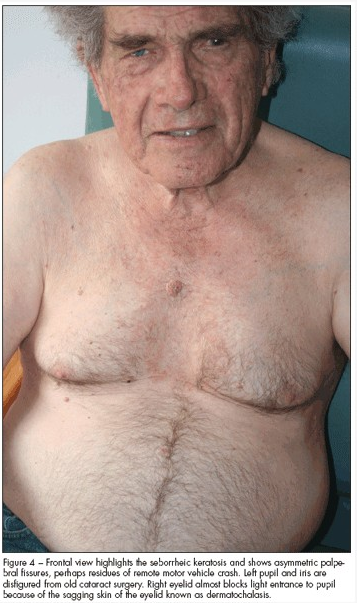An Aged Man With One Big Chest Lesion and a Scattering of Smaller Ones
 HISTORY
HISTORY
A 78-year-old man is seen upon admission to behavioral hospital unit. Agitation and visual hallucinations led to this admission. A similar prior episode, complicating his established Lewy body dementia, cleared with hospitalization and clozapine therapy.
PHYSICAL EXAMINATION
Mildly obese man who is conversationally capable and friendly, though dementia is also evident. Vital signs normal. Has a large central sternal seborrheic keratosis. Skin about right breast as shown. Murmur consistent with aortic stenosis. Ventral hernia.
What’s Your Diagnosis?
WHY IS THIS MORE THAN A CURIOSITY?
Accessory breasts and polythelia have commanded extraordinary attention since antiquity, sometimes being interpreted as a sign of augmented fertility.2,3 For instance, the Phoenician goddess Astarte and her Greek descendants, including Artemis, are often depicted as having polymastia.
Polymastia and polythelia were regarded at other times and places as marks of the Devil. In one extraordinary rumor, Anne Boleyn was said to have a third breast over midsternum. Of course, this could have been an element of false evidence adduced by King Henry’s minions to justify the royally sanctioned murder. The broad historical review of accessory breast tissue by Grossl2 offers further instances.
 Cosmetic considerations sometimes lead to surgical interventions,4 but this patient expresses no such concerns nor does his wife, who is highly articulate. One paper in the literature entitled “Polythelia Is Not a Mere Aesthetic Issue”5 fails to prove the title assertion. Other authors give more compelling evidence.
Cosmetic considerations sometimes lead to surgical interventions,4 but this patient expresses no such concerns nor does his wife, who is highly articulate. One paper in the literature entitled “Polythelia Is Not a Mere Aesthetic Issue”5 fails to prove the title assertion. Other authors give more compelling evidence.
Supernumerary breasts can be the site of any of the diseases of ordinary breasts, including carcinoma. Since pure (non-Paget) cancer of the nipple occurs with such rarity, the cancer concern with pure polythelia is not local but distant.
INTERNAL DISORDERS
Numerous reports detail an association with renal and ureteral abnormalities, including renal cell carcinoma. 6,7 The numbers of associated nephrourinary abnormalities vary widely, and non-neoplastic lesions predominate: unilateral renal agenesis, reduplication of collecting systems, and unilateral or bilateral stenosis of the ureteropelvic junction. Noninvasive assessment for these problems has become considerably safer since the ultrasound scan of the abdomen and pelvis replaced most uses of the excretory urogram (often called the intravenous pyelogram, or IVP). For children and younger adults in whom polythelia is detected, this follow-up is recommended.
In the total context of our patient’s care and preferences, we exhibited diagnostic restraint and did not order the study. We discussed the association with the primary care physician so that our decision could readily be revisited and reversed if the parties so chose. It is not yet clear to what degree polythelia is a marker for internal disease in adults and even in pediatric patients8; nor what difference it makes if the polythelia is familial versus sporadic.9 At least one study includes nocturnal enuresis and urinary incontinence without structural anomaly among the “renal-urinary abnormalities” group, thereby clouding the conclusion that polythelia is more common in children with urinary tract disorders than in those without.10 We don’t know if the proposed association with fetal alcohol syndrome is established.11 However, we note inclusion of polythelia among one respected listing of genodermatoses with malignant potential.12
SECONDARY ISSUES
A great many other associations with polythelia have been proposed, but many fail to withstand scrutiny: eg, hypertension, with its very high background rate. One could postulate that the associated renal abnormalities themselves cause hypertension; however, many of the associated urinary tract disorders do not (eg, renal cancers, solitary kidney, reduplicated collecting systems).
The pigmented lesion medial to the lower of the two accessory nipples was seen by the dermatologist, but his index of suspicion was low enough that he recommended only serial clinical observation.
Finally, we present this case because it yet again exemplifies the principle that the largest or most striking lesion need not be the most important: the tiny pigmented lesion mattered more than the giant seborrheic keratosis, and if we had chosen to pursue the associations of polythelia, so would these small aberrations in the skin.


